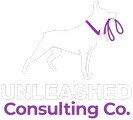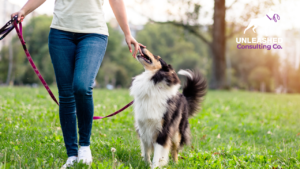Are you struggling to get more clients for your dog training business?
If so, you’re not alone. Many dog trainers face the same challenge, but a solution is Google Ads. Google Ads helps you reach potential clients right when they’re searching for dog training services online. By showing your ads to people in your area who need help with their dogs, you can grow your business faster than relying on word-of-mouth alone.
In this guide, you’ll learn the most effective tips and strategies to make Google Ads work for your dog training business.
Let’s get started!
Why Google Ads Matter for Dog Trainers
If you’re a dog trainer, Google Ads can be one of the best tools to help your business grow. But why is it so important?
Overview of Google Ads and Its Importance in Pet Services
Google Ads is an online advertising platform that lets you show your business to people who are actively searching for services like dog training. For example, if someone types “dog trainer near me” into Google, your ad can appear at the top of their search results. This gives you a chance to connect with potential clients right when they need your services.
In the pet services industry, dog owners often search online for trainers, and Google Ads helps make sure they see your business first.
Benefits of Using Google Ads Over Traditional Marketing
Compared to traditional marketing methods—like flyers or newspaper ads—Google Ads has some clear advantages:
- Targeting the Right People in Real Time: Google Ads shows your ads only to people who are searching for dog training services right now. This means you’re reaching people who are already interested in what you offer.
- Control Over Your Budget: You can set a daily budget, so you only spend what you’re comfortable with. Plus, you pay only when someone clicks on your ad.
- Fast Results: Unlike other types of marketing that take time to see results, Google Ads can bring in leads quickly, helping you grow your client base faster.
Statistics on Google Ads Effectiveness for Service-Based Businesses
Google Ads has proven to be highly effective for businesses that provide services, like dog training. Here are some numbers that show how powerful it can be:
- 65% of people click on Google Ads when they’re ready to buy or sign up for a service.
- 90% of consumers say ads influence their decisions, especially when they’re looking for local services.
- On average, businesses make $8 for every $1 spent on Google Ads.
By using Google Ads, you can reach the right clients at the right time, helping your dog training business grow faster and more effectively than traditional methods.
How To Set Up a Successful Google Ads Campaign for Dog Training
Ready to start using Google Ads to grow your dog training business? Here’s a simple, step-by-step guide to get you going.
Step 1: Creating a Google Ads Account
Before you can launch your ads, you’ll need to create a Google Ads account. Here’s how:
- Go to Google Ads: Visit ads.google.com and click on the “Start Now” button.
- Sign in with a Google account: If you have a Gmail account, you can use that to sign in. If not, you’ll need to create one.
- Set up your first campaign: Once you’re signed in, Google will guide you through the process of creating your first ad campaign.
Step 2: Setting Campaign Goals
Now that your account is ready, it’s time to set some goals. What do you want to achieve with your ads? Here are a few common goals for dog trainers:
- Brand Awareness: If you’re just starting out, you may want to focus on getting your name out there so potential clients know you exist.
- Lead Generation: If you’re looking to get more inquiries or bookings, your goal might be to drive more leads to your website or phone line.
Choose the goal that matches what you need most right now.
Step 3: Choosing the Right Campaign Type for Dog Training
Google Ads offers different types of campaigns, but for dog training, the Search campaign is often the best choice. This type of campaign shows your ads when people search for things like “dog training near me” or “puppy training services.”
Here are the two most common options:
- Search Campaigns: These show your text ads at the top of Google search results. It’s a great way to reach people who are already looking for dog trainers.
- Display Campaigns: These ads appear on websites or apps that your target audience visits. They’re more visual and can help build awareness, but they don’t target people actively searching for dog training as directly as Search ads do.
For most dog trainers, starting with a Search Campaign is the most effective strategy.
Step 4: Setting a Budget and Managing Ad Spend
One of the biggest benefits of Google Ads is that you control how much you spend. You can set a daily budget and decide how much you’re willing to spend for each click on your ad (this is called your bid).
Here’s how to set a budget:
- Start small: If you’re new to Google Ads, start with a small daily budget (e.g., $10–$20 per day) and see how your ads perform.
- Adjust based on performance: As you get more comfortable, you can increase your budget or adjust it based on the number of leads or bookings you’re getting.
- Keep an eye on your ad spend: Google Ads lets you track how much you’re spending in real time. If you notice you’re getting lots of clicks but no leads, it might be time to tweak your ad or keywords.
With these steps, you’ll be on your way to setting up a successful Google Ads campaign that helps you attract more dog training clients!
How To Do Google Keyword Research for Dog Training Ads
One of the most important steps to running a successful Google Ads campaign for your dog training business is choosing the right keywords. Keywords are the words and phrases people type into Google when they’re looking for services like dog training. If you pick the right ones, you can reach people who are actively searching for what you offer.
The Importance of Keywords in Google Ads
Keywords are the backbone of any Google Ads campaign. When someone searches for “dog training near me,” Google uses the keywords in your ad campaign to decide if your ad should appear. Choosing the right keywords helps you:
- Reach the right audience: You want your ads to show up for people looking for dog trainers in your area, not random searches.
- Save money: Good keywords make sure you’re not wasting money on clicks from people who aren’t interested in your services.
- Get more leads: The better your keywords, the more likely it is that people will click on your ad and become clients.
How to Find High-Converting Keywords Specific to Dog Training
To attract potential clients, you need to focus on keywords that match what dog owners are searching for. Here are some ideas:
- Location-based keywords: Most people look for trainers in their area. Use keywords like “dog training near me,” “dog trainer [your city],” or “puppy obedience classes in [your location].”
- Service-specific keywords: Think about the services you offer. People might search for “puppy training,” “aggressive dog training,” “obedience classes,” or “in-home dog training.”
- Niche keywords: If you specialize in something unique, such as training for aggressive dogs or service dog training, use those in your keywords.
These types of keywords will help you attract people who are looking for exactly what you offer.
Tools to Use for Google Ads Keyword Research
To find the best keywords, you can use several tools that help you see what people are searching for:
- Google Keyword Planner: This free tool from Google helps you discover new keywords and see how often they’re searched. You can also get ideas based on your website or services.
- SEMrush: This tool provides deeper insights into what keywords your competitors are using and what’s driving traffic to their sites. It can help you discover keywords that are often overlooked.
- Ubersuggest: Another helpful tool for finding keyword ideas and seeing how competitive they are. It also suggests variations of keywords that might work better.
These tools will help you find the most effective keywords for your dog training business.
How to Categorize Keywords for Better Targeting
Once you have a list of keywords, you’ll need to organize them in a way that makes them work best for your ads. Google Ads lets you choose different types of keyword match settings, which control how closely a keyword has to match what someone types into Google before your ad shows up. Here’s how to use them:
- Broad Match: Your ad shows up when someone searches for anything related to your keyword. This gives you the widest reach, but it might not always be specific. For example, if you choose the broad match keyword “dog training,” your ad could show up for searches like “dog grooming” or “dog toys,” which aren’t relevant.
- Phrase Match: Your ad appears when someone searches for a phrase that includes your keyword in the exact order. For example, if you choose “dog training classes,” your ad would show up for searches like “local dog training classes” or “dog training classes near me.”
- Exact Match: Your ad only appears when someone types the exact keyword you’ve chosen. This gives you the most precise targeting but limits your reach. If you use “dog training near me” as an exact match keyword, your ad will only show for people who type that phrase exactly.
Using a mix of these keyword types ensures that you’re reaching the right audience while also getting a broad enough reach to bring in new clients.
By choosing the right keywords and using the right tools, you’ll attract more dog training clients and get the most out of your Google Ads campaign.
Creating Compelling Ad Copy for Dog Training Services
The ad copy you write is one of the most important factors in getting potential clients to click on your ad. You want your Google Ads to stand out, catch attention, and convince dog owners that you’re the right person to help them with their dog training needs. Let’s break down how to write great ad copy for your dog training services.
Writing Attention-Grabbing Headlines That Speak to Dog Owners’ Needs
Your headline is the first thing people see in your ad, and it’s your chance to grab their attention. Since dog owners are searching for specific solutions, your headline should speak directly to their needs.
Here are some tips for writing effective headlines:
- Address Their Problem: Think about the problems dog owners are dealing with, like behavior issues or puppy training, and highlight how you can help. Example: “Stop Bad Dog Behavior Fast!”
- Include Location: Since people often search for local services, adding your location helps show you’re nearby. Example: “Expert Dog Training in [Your City].”
- Use Action Words: Encourage people to take action by using strong words like “Get,” “Start,” or “Book.” Example: “Book Your Puppy Training Session Today.”
- Highlight Expertise: If you have special qualifications, like being a certified trainer or having years of experience, mention that in your headline. Example: “Certified Dog Trainer with 10+ Years of Experience.”
Your headline should be clear, to the point, and show why a dog owner should choose you over the competition.
Best Practices for Ad Descriptions
Your ad description gives you a little more space to explain why dog owners should click on your ad. Here’s where you can highlight your unique selling points—what sets you apart from other trainers.
What to Include in Your Description:
- Focus on Benefits: Instead of just listing your services, explain what benefits clients will get. Think about how your training can make their life easier or their dog better behaved. Example: “Transform Your Dog’s Behavior with Our Positive Reinforcement Techniques.”
- Highlight Unique Selling Points: What makes you different? Are you a certified trainer? Do you use gentle, science-based methods? Mention anything that makes your service stand out. Example: “Certified Trainer Specializing in Positive, Humane Dog Training.”
- Call to Action (CTA): Encourage people to take the next step, like calling you, visiting your website, or booking a session. A good CTA pushes the reader to act right away. Example: “Call Now for a Free Consultation!”
- Use Keywords: Make sure you include relevant keywords in your description, such as “dog training,” “puppy classes,” or “obedience training.” This helps your ad appear in searches related to those services.
Example of an Effective Ad:
Headline: “Certified Dog Trainer in [Your City] – Book Now” Description: “Stop unwanted behaviors fast with our expert dog training services. Positive, science-based methods. Call now for a free consultation!”
Tips for Writing Great Ad Copy:
- Keep It Simple: Google Ads has limited space, so use short, clear sentences.
- Make It Relevant: Always match your ad copy to what people are searching for. If they’re looking for puppy training, focus on that instead of general dog training.
- Show Credibility: Mention any awards, certifications, or special experience that sets you apart.
Creating ad copy that speaks to dog owners’ needs, highlights your unique strengths, and encourages action will make your ads more compelling and help you attract more clients to your dog training business.
Targeting the Right Audience: Geo-Targeting & Demographics
To get the most out of your Google Ads for dog training services, you need to make sure your ads are shown to the right people. This means targeting the right audience based on their location and other characteristics. Let’s look at how you can do this effectively.
How to Narrow Down Your Audience Based on Location
One of the best ways to target your ads is by using geo-targeting. This means you focus your ads on people who live in specific areas, such as your city or neighborhood. Here’s how to do it:
- Set Your Location: When you create your Google Ads campaign, you can specify the locations where you want your ads to show up. For example, if you’re a dog trainer in Atlanta, you might choose to target people in Atlanta and the surrounding suburbs.
- Focus on Local Searches: Dog owners typically look for trainers near them, so including local keywords in your ads is essential. Phrases like “dog training in [Your City]” or “puppy training near me” help ensure your ads reach the right audience.
- Use Radius Targeting: If you want to reach dog owners within a certain distance from your training facility, you can set a radius around your location. For example, you might choose to show your ads to anyone within a 10-mile radius of your business.
Using Demographic Data to Fine-Tune Your Targeting
In addition to location, you can also use demographic data to better target your ads. This includes factors like:
- Age: Knowing the age range of your ideal clients can help. For example, if you mainly work with young families, you might want to target ads to people aged 25-40.
- Income: Understanding the income level of your target audience can guide your pricing and marketing. If you offer premium services, you might want to target higher-income neighborhoods.
- Pet Ownership: Google Ads allows you to target audiences based on their interests, including pet ownership. You can create ads specifically aimed at dog owners, which helps ensure your message reaches those most likely to need your services.
Using Remarketing Campaigns to Retarget Past Website Visitors
Not everyone who sees your ad will click and book your services right away. That’s where remarketing campaigns come in. Remarketing allows you to show ads to people who have already visited your website, reminding them about your services and encouraging them to return.
Here’s how to set up remarketing:
- Install a Remarketing Tag: You need to add a small piece of code (a remarketing tag) to your website. This code collects data about visitors to your site.
- Create Custom Ads: You can design ads specifically for people who have visited your website before. For example, if someone looked at your puppy training page but didn’t book a session, you could create an ad that reminds them about that service.
- Target Previous Visitors: In your Google Ads settings, you can choose to show your remarketing ads only to people who have been to your website in the past 30 days, 60 days, or any time frame you choose.
By using geo-targeting, demographic data, and remarketing campaigns, you can ensure that your Google Ads are reaching the right audience. This targeted approach will help you attract more local dog owners and ultimately grow your dog training business.
Tracking and Optimizing Your Google Ads Performance
Once your Google Ads campaign is up and running, it’s crucial to monitor how well it’s performing and make adjustments to improve results. Tracking and optimizing your ads can help you get the most out of your advertising budget. Here’s a simple guide to understanding how to do this effectively.
How to Set Up Google Analytics to Track Conversions and ROI
Google Analytics is a powerful tool that helps you understand how people interact with your website after clicking on your ads. Here’s how to set it up:
- Create a Google Analytics Account: If you don’t have one yet, go to analytics.google.com and sign up for a free account.
- Add Tracking Code to Your Website: Once your account is set up, Google will give you a tracking code. You need to add this code to every page of your website. This allows Google Analytics to collect data on visitors.
- Set Up Goals for Conversions: In Google Analytics, you can define what a “conversion” is for your dog training business. This might be when someone fills out a contact form, books a session, or calls your business. Setting up these goals helps you track how many people are completing these actions after clicking your ads.
- Monitor Your Return on Investment (ROI): By tracking conversions, you can calculate how much money you’re making from your ads compared to what you’re spending. This is your ROI. For example, if you spend $100 on ads and get $300 in bookings, your ROI is 300%.
Key Performance Metrics to Monitor
To understand how well your ads are doing, keep an eye on these important performance metrics:
- Click-Through Rate (CTR): This shows the percentage of people who clicked on your ad after seeing it. A high CTR means your ad is engaging and relevant to your audience. You want to aim for a CTR of at least 2% to 5% for good performance.
- Quality Score: This score, given by Google, measures how relevant your ad is to the keywords you’re targeting. A higher Quality Score can lead to lower costs per click and better ad placements. You can improve your Quality Score by using relevant keywords, writing good ad copy, and having a well-structured landing page.
- Conversion Rate: This measures the percentage of visitors who complete your desired action after clicking on your ad. For example, if 10 people visit your site and 2 book a session, your conversion rate is 20%. A higher conversion rate indicates your ads and landing pages are effective.
A/B Testing Your Ads to Improve Performance
A/B testing, also known as split testing, is a great way to find out what works best in your ads. Here’s how to do it:
- Create Two Versions of Your Ad: Change one element at a time—like the headline, description, or call to action—so you can see which version performs better. For example, you could create one ad with the headline “Expert Dog Training in [Your City]” and another with “Get Your Dog Trained Today!”
- Run Both Ads Simultaneously: Show both versions of your ad to similar audiences at the same time. This way, you can fairly compare their performance.
- Analyze Results: After running your ads for a set period (usually a week or two), check which ad performed better based on your key metrics like CTR and conversion rate.
- Make Improvements: Use the winning ad as your new standard and continue testing new changes to keep improving your performance.
Common Mistakes to Avoid in Google Ads and How to Fix Them
Even experienced advertisers can make mistakes. Here are some common pitfalls and how to fix them:
- Not Using Keywords Effectively: If you’re not using the right keywords, your ads may not show to the right audience. Regularly update and refine your keywords based on performance data to ensure they align with what potential clients are searching for.
- Ignoring Negative Keywords: Negative keywords prevent your ads from showing for irrelevant searches. For example, if you don’t offer puppy grooming, you can add “grooming” as a negative keyword to avoid those clicks. Regularly review and update your negative keyword list.
- Failing to Optimize Landing Pages: If your landing page doesn’t match what your ad promises or isn’t user-friendly, visitors may leave without taking action. Make sure your landing page provides clear information and a strong call to action.
- Overlooking Ad Scheduling: If your ads are running when your target audience isn’t looking, you may waste money. Use ad scheduling to show your ads during the times when potential clients are most likely to search for dog training services.
By tracking your performance, using the right metrics, testing your ads, and avoiding common mistakes, you can optimize your Google Ads campaign. This will help you attract more clients to your dog training business and get the best results from your advertising efforts.
Conclusion
Google Ads can be a game-changer for dog trainers looking to grow their business and reach more clients. Throughout this guide, we’ve explored the importance of Google Ads in the pet services industry, providing you with effective strategies to set up, target, and optimize your campaigns for maximum impact.
Take action today by applying the insights from this guide, and watch as your dog training business grows and thrives in the digital landscape!
Ready to take your dog training business to the next level?
At Unleashed Consulting, we specialize in helping pet service providers like you maximize their marketing efforts, including Google Ads. Contact us today to learn how we can help you create tailored marketing strategies that drive results and grow your business!
Frequently Asked Questions
1. How much should I budget for Google Ads for dog training?
Your budget for Google Ads can vary based on your goals and the competitiveness of your area. A good starting point is to set aside at least $300 to $500 per month. This allows you to test different ads and see what works best. As you start to get more clients and see positive results, you can increase your budget to get more visibility.
2. What are the best keywords to use for dog training services?
The best keywords for dog training services are terms that potential clients might use when searching for help. Some effective keywords include:
- “dog training near me”
- “puppy training classes”
- “obedience training for dogs”
- “dog behavior training”
- “certified dog trainer in [Your City]”
Using these specific phrases can help you reach local dog owners looking for your services.
3. Can I run Google Ads if I’m new to dog training?
Yes, you can run Google Ads even if you’re new to dog training! While it may take some time to learn the ropes, Google Ads can help you attract clients quickly. Focus on creating clear, informative ads that highlight your services, and don’t hesitate to use resources and guides (like this one!) to help you along the way. You can also consider partnering with a marketing agency, like Unleashed Consulting, to help you get started effectively.








